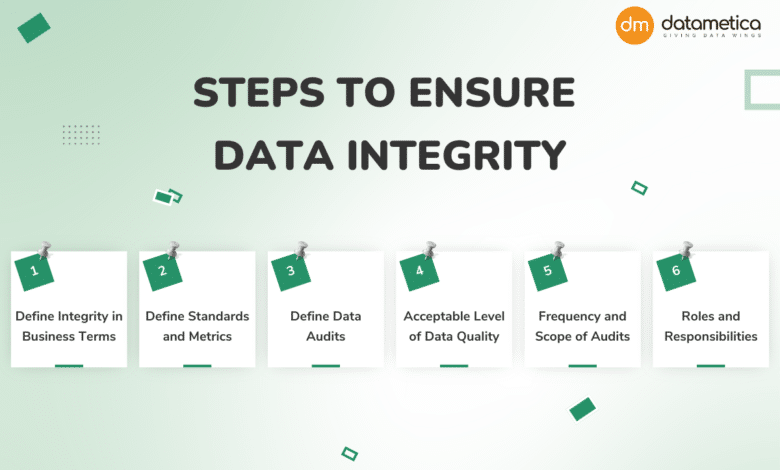What Are the Objectives of Ensuring Data Integrity?: A Step-by-Step Guide

Data integrity is a crucial aspect of modern information systems. As organizations rely heavily on data for decision-making, ensuring data integrity becomes paramount. This article will explore the objectives of ensuring data integrity, focusing on its importance and the methods used to achieve it.
What Is Data Integrity?
Data integrity refers to the accuracy, consistency, and reliability of data throughout its lifecycle. It ensures that data is not altered or tampered with, maintaining its quality and usability. Data integrity is essential in various sectors, including finance, healthcare, and research.
Why Is Data Integrity Important?
- Trustworthiness of Data: When data is accurate, stakeholders can trust the information for decision-making. This trust is vital for effective operations and strategic planning.
- Regulatory Compliance: Many industries are subject to regulations that mandate data integrity. Ensuring compliance helps organizations avoid legal penalties and maintain their reputation.
- Risk Management: Poor data integrity can lead to significant risks, including financial loss and operational inefficiencies. Organizations can mitigate these risks by ensuring their data remains intact and accurate.
Objectives of Ensuring Data Integrity
1. Maintaining Accuracy
One of the primary objectives of ensuring data integrity is to maintain data accuracy. This means that the data must reflect the real-world conditions it represents. Accurate data is crucial for:
- Effective Decision-Making: Organizations rely on data to make informed decisions. Inaccurate data can lead to poor choices, affecting overall performance.
- Operational Efficiency: Accurate data helps streamline operations. When data is correct, processes can be executed smoothly, reducing delays and errors.
2. Ensuring Consistency
Consistency is another key objective. Data should remain consistent across different databases and systems. This consistency ensures that all stakeholders are working with the same information. To achieve consistency, organizations can:
- Implement Data Governance Policies: Establishing clear policies regarding data entry and management can help maintain consistency across various platforms.
- Use Centralized Databases: Centralized systems reduce the likelihood of discrepancies by providing a single source of truth.
3. Enhancing Reliability
Reliability refers to the trustworthiness of data over time. Ensuring data integrity helps maintain this reliability. Reliable data allows organizations to:
- Build Trust with Stakeholders: When data is consistently reliable, stakeholders, including customers and partners, are more likely to trust the organization.
- Support Long-Term Planning: Reliable data is essential for long-term strategies. Organizations can plan more effectively when they know their data will not change unexpectedly.
4. Protecting Data from Corruption
Data corruption can occur due to various factors, including hardware failures, software bugs, or malicious attacks. One objective of ensuring data integrity is to protect against these threats. This can be achieved through:
- Regular Backups: Regularly backing up data ensures that organizations can recover information if it becomes corrupted.
- Access Controls: Implementing strict access controls helps prevent unauthorized alterations to data, protecting its integrity.
5. Supporting Data Lifecycle Management
Data integrity is essential for effective data lifecycle management. Organizations must manage data from its creation to its deletion. Key aspects include:
- Data Retention Policies: Establishing policies on how long to keep data helps manage its lifecycle while ensuring integrity.
- Regular Audits: Conducting regular audits of data helps identify any integrity issues and address them promptly.
6. Facilitating Compliance
Compliance with regulations is a critical objective for many organizations. Ensuring data integrity helps organizations meet legal and regulatory requirements. This is particularly important in industries like finance and healthcare, where data integrity is mandated by law. Organizations can:
- Document Processes: Keeping detailed records of data management processes aids in demonstrating compliance during audits.
- Train Employees: Educating employees about the importance of data integrity ensures that everyone is aware of their responsibilities.
7. Improving Customer Satisfaction
Ensuring data integrity also plays a significant role in customer satisfaction. When customers receive accurate and timely information, their experience improves. Objectives in this area include:
- Providing Accurate Information: Ensuring that customer data is accurate allows organizations to provide better service.
- Enhancing Communication: Reliable data enables effective communication with customers, improving their overall experience.
8. Enabling Better Analytics
Data integrity is crucial for effective data analysis. Accurate and reliable data allows organizations to derive meaningful insights. This includes:
- Improved Decision-Making: Organizations can make better decisions when their data is trustworthy.
- Identifying Trends: Reliable data enables organizations to identify trends and patterns that can inform strategic initiatives.
Methods for Ensuring Data Integrity
To achieve the objectives outlined above, organizations can implement various methods for ensuring data integrity:
1. Data Validation
Implementing data validation checks ensures that only accurate and consistent data is entered into systems. This can include:
- Automated Checks: Using automated validation tools can quickly identify errors during data entry.
- Manual Reviews: Regular manual reviews of data can help catch discrepancies that automated systems might miss.
2. Data Encryption
Encrypting data protects it from unauthorized access. This method ensures that even if data is intercepted, it cannot be altered without the proper keys.
3. Regular Backups
Regularly backing up data protects against loss and corruption. Organizations should establish a backup schedule to ensure data is always recoverable.
4. Access Controls
Implementing strict access controls ensures that only authorized personnel can modify data. This reduces the risk of intentional or accidental data alterations.
5. Audits and Monitoring
Conducting regular audits and monitoring data systems can help identify potential integrity issues. Organizations should have a process in place to address any findings promptly.
Conclusion
Ensuring data integrity is vital for organizations in today’s data-driven world. The objectives outlined—maintaining accuracy, consistency, reliability, and protection against corruption—are crucial for effective operations. By implementing strategies such as data validation, encryption, and regular audits, organizations can achieve these objectives. Ultimately, ensuring data integrity not only enhances decision-making and compliance but also improves customer satisfaction and organizational efficiency. Emphasizing data integrity will lead to a more trustworthy and effective organization.




